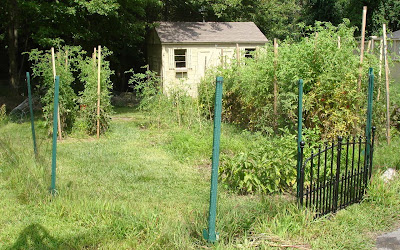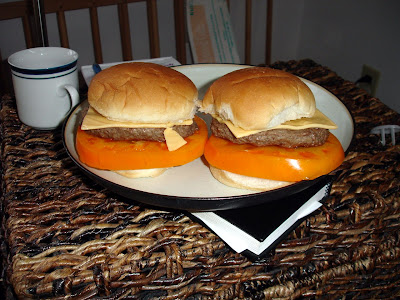 I was about to respond to the Tomato State comment in my previous post on how I plant tomatoes there in the comments section, but decided that a post would be better suited to the task. Declaring any one way the best to do something in the garden is antithetical to how I see gardening. There are many ways to accomplish the same task in the garden and each has advantages depending on innumerable variables. I took the above photo last year, in August, when my tomatoes were at their peak. The stakes supporting the weave are over six and a half feet tall as measured from the ground, and the tomato plants grew even taller than that. I did not pinch suckers on the majority of the plants - I simply added them into the weave and ran them up as secondary vines. These suckers produced many tomatoes for me. Still, each system of supporting tomatoes, or not supporting them, has advantages.
I was about to respond to the Tomato State comment in my previous post on how I plant tomatoes there in the comments section, but decided that a post would be better suited to the task. Declaring any one way the best to do something in the garden is antithetical to how I see gardening. There are many ways to accomplish the same task in the garden and each has advantages depending on innumerable variables. I took the above photo last year, in August, when my tomatoes were at their peak. The stakes supporting the weave are over six and a half feet tall as measured from the ground, and the tomato plants grew even taller than that. I did not pinch suckers on the majority of the plants - I simply added them into the weave and ran them up as secondary vines. These suckers produced many tomatoes for me. Still, each system of supporting tomatoes, or not supporting them, has advantages.The Florida Weave is what I use because all of the materials for it are biodegradable. I actually appreciate the fact that my stakes will rot eventually. The twine I simply compost along with the vines.
This system provides support for the secondary vines as well as the main vine, which allows me to support many tomato plants for relatively low cost. However, the down-side of the reduced cost is that this method is labor intensive. When they are growing fast, a row of tomatoes must be restrung every couple of days. The time adds up to hours a week, because you need to be careful not to harm the vines in the process.
The Florida weave is a balancing act between keeping the strings too tight or too loose. It also does not inherently provide good lateral support. I found I had to add additional bamboo supports to some of the plants that were carrying tomatoes that weighed up to a pound and a half each. I didn't mind having to do this. At other times I tied the vines to the strings of the Florida weave to keep them from sliding back and forth against one-another in high winds.
I'll be using the Florida weave again this year, which I suppose is the highest endorsement I can give it.
This year, in between the two tall rows of tomatoes I have planted a mixed row of various veggies, as well as some additional staked tomatoes. I also had staked tomatoes in other locations. Stakes can be effective, but they require that you heavily prune the vine down to the main stem. If you don't remove the secondary vines, the lack of support will lead to them cracking under the weight of maturing tomatoes.
The tomato stake mentioned in the original comment is only five feet tall. The shorter height means that in addition to removing suckers, you will have to cut off the top of the vine once it reaches the top of the stake. Additionally, because it is plastic, the product will be around for long after you (and your tomatoes) are gone. Plastic issues aside, if you are growing determinate tomato varieties and if you are willing to heavily prune, this stake could work; but when using stakes I would still rather use an eight-foot wooden pole and twine. Bamboo also works - but if you use bamboo make sure it is at least an inch in diameter, or it will give up the ghost under the load.
Tomato cages do not compare favorably to either stakes or the Florida weave. They are almost universally too short to support any indeterminate tomato variety. The openings are too large to provide appropriate support for the tomato branches. And once they are mangled beyond use, which doesn't take long, they are likely to be too rusted or just too unwieldy to recycle.
For those who do want to use cages, the best approach I've seen is to make your own. You can buy a roll of 6' tall fencing of an appropriate length for the number and size of cages you want to make for far less than it would cost to buy the pre-made ones. The natural curl of the roll practically forms the cage circle for you. A few quick snips and bends keeps everything in place. As an experiment, this year I have made a couple of these from my left-over fencing. Tomato lovers at Tomatoville report that this approach produces positive results.
As yet another alternative to growing tomatoes, a nearby farm allows their plants to sprawl out over a protective layer of plastic mulch. While I don't like plastic mulch, their tomato plants look good and require nearly no maintenance. I'm not sure this would work with sprawling over organic mulch because something living in the mulch would love to dine on tomatoes sitting on the ground. But if you're a plastic lover, sprawling can work.
I know that some people set up beams or wires that they then hang string down from. Strings are hung from this structure, and individual, pruned vines are then trained up the strings. In my mind this is like the stake method, only you're using a string instead of a stake. With a permanent in-ground cemented support and a cross-wire, the cost for this setup in the long run could remain very low. I am somewhat tempted to try this, but my reluctance to prune prevents me from doing so.
I hope this rundown of support options is helpful to someone and if anyone has other methods you would like to propose, feel free! Whatever method you choose, I hope you have many tasty results.
To wrap up, here are some of my results from last year:
 I think these would have to be called "tomato burgers with cheese". The slices came from a one-and-three-fourths-pound yellow beefsteak that I believe was Kellogg Breakfast, if my memory serves me. Those are standard grocery-store hamburger buns, by the way.
I think these would have to be called "tomato burgers with cheese". The slices came from a one-and-three-fourths-pound yellow beefsteak that I believe was Kellogg Breakfast, if my memory serves me. Those are standard grocery-store hamburger buns, by the way. The yellow cherry tomatoes were from a tomato variety called Lollipop. They lived up to their namesake: sweet and delicious. I could never eat just one. The Black Cherry tomatoes were also excellent, having a deliciously complex aftertaste.
The yellow cherry tomatoes were from a tomato variety called Lollipop. They lived up to their namesake: sweet and delicious. I could never eat just one. The Black Cherry tomatoes were also excellent, having a deliciously complex aftertaste. These slicers ended up in a tomato sauce that we had thought we would end up freezing. It was so good that it didn't last the week.
These slicers ended up in a tomato sauce that we had thought we would end up freezing. It was so good that it didn't last the week. Posting all of those has me drooling. I can't wait for the tomatoes of summer!
Posting all of those has me drooling. I can't wait for the tomatoes of summer!







3 comments:
MMM.. tomato burger, minus bread and beef add cottage cheese, miracle whip and paprika sounds great.
:) Opa
Your burgers made me hungry, but its too early for dinner.
I realize we have different systems, now that you post last years...
I agree with you, whatever works for you and the joy of coming up with your own way that does work. The inventiveness is part of the fun!
NYG I'll be watching your blog for photos. I'm always looking to learn different techniques.
Post a Comment